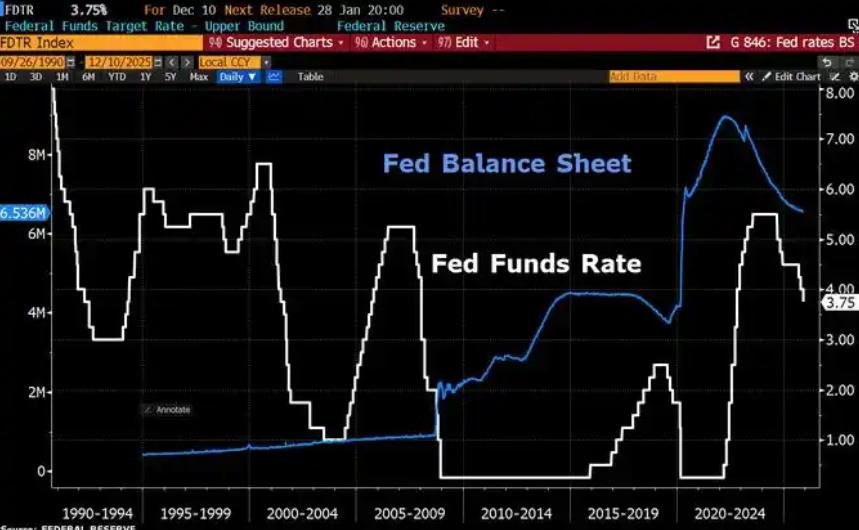
October 24 witnessed a notable upward trend in U.S. Treasury yields, with yields across all maturities rising in a balanced manner. Specifically, the 2-year Treasury yield climbed 4.82 basis points to 3.489%, while the 3-year yield advanced 5.84 basis points to 3.497%. The 5-year yield led the gains among short-to-medium-term securities, rising 5.90 basis points to 3.605%. Of particular note, the 10-year Treasury yield increased by 5.35 basis points to 4.001%, reclaims the critical psychological 4% level after a three-day gap. Concurrently, the 30-year long-term yield also rose 4.90 basis points to 4.578%, maintaining an overall steepening shape of the yield curve.
From the perspective of intraday trading dynamics, U.S. Treasury futures already showed signs of pressure during the early trading session. As U.S. stock indices extended their gains in the afternoon, selling pressure intensified, ultimately driving yields to intraday highs. Options market data revealed that 274,700 put options on the 10-year Treasury (expiring in November with a strike price of 113.00) were traded on the day, far exceeding the 74,800 outstanding contracts. This reflects the market's active hedging against the risk of yields breaking above 4.05%.
Volatility in energy prices served as the immediate trigger for the day's bond market adjustment. Following the U.S. imposition of new sanctions on major Russian oil companies, international oil prices surged sharply, with WTI crude oil futures rising 5.5% intraday and remaining at elevated levels. This sudden jump in oil prices directly impacted market inflation expectations, prompting investors to reassess medium-to-long-term price pressures and thereby curbing demand for fixed-income Treasury securities. Such inflation concerns were evidenced in the auction of 5-year Treasury Inflation-Protected Securities (TIPS). The yield awarded at the TIPS auction on the day was approximately 1 basis point higher than the pre-auction trading level, indicating an increase in investors' demand for inflation compensation and indirectly pushing up the pricing benchmark for regular Treasury yields.
The U.S. Treasury's debt issuance rhythm provided medium-to-long-term support for the upward movement of yields. Data showed that the net supply of U.S. Treasury bills this month was approximately 146billion,80 billion more than market expectations. Additionally, the Treasury plans to further raise the balance of the "Treasury General Account (TGA)" from 850billionto900 billion or even higher. Large-scale debt issuance, combined with the Federal Reserve's ongoing balance sheet reduction (quantitative tightening), has led to a continuous depletion of bank system reserves. Currently, bank reserves stand at around $3 trillion, approaching the threshold of the "ample level." Market concerns about liquidity tightening have exacerbated selling pressure on Treasury bonds. Strategists at Barclays noted that this dual squeeze from supply and liquidity will eventually force the Federal Reserve to adjust its policies, but in the short term, it will continue to support higher yields.
The strength of the U.S. stock market created a fund diversion effect on the bond market. Led by large-cap technology stocks, major U.S. stock indices closed higher across the board on the day. The increased attractiveness of risk assets prompted some funds to shift from the Treasury market to equities, further amplifying selling pressure on Treasuries. This stock-bond seesaw effect was particularly pronounced during liquidity-sensitive trading sessions. Meanwhile, the upcoming Federal Reserve policy meeting next week, coupled with the release of CPI data on Friday, left the market in a state of expectation-driven uncertainty. Although institutions such as JPMorgan predict that the Federal Reserve will halt its balance sheet reduction this month, the specific timing of the policy shift remains unclear. As a result, investors chose to reduce their Treasury holdings to avoid uncertainties ahead of the key data release.
The upward movement of U.S. Treasury yields has triggered cross-market spillover effects. In the foreign exchange market, the U.S. Dollar Index strengthened supported by higher yields, aligning with the dollar's strength amid the "Trump trade" backdrop. Within the stock market, differentiation emerged: interest rate-sensitive growth stocks saw narrowed gains, while cyclical sectors such as energy stocks outperformed due to rising oil prices. For the real economy, the short-term upward movement of yields has not yet significantly impacted the financing market, but potential transmission effects warrant vigilance. Currently, the 30-year mortgage rate remains at a more than one-year low, and its supportive role in the housing market has not diminished. However, if long-term yields continue to break above the 4% range, it may gradually push up corporate financing costs, posing potential risks to the pace of economic recovery.
In the short term, the September CPI data to be released on Friday will be a key variable shaping market trends. The market expects core CPI to remain unchanged month-on-month and headline CPI to rise 3.1% year-on-year, still above the Federal Reserve's 2% target. If the data exceeds expectations, it may push the 10-year yield above 4.05%; conversely, lower-than-expected data could trigger a yield pullback. In the medium-to-long term, the interplay between fiscal pressure and shifts in monetary policy will dominate the direction of the bond market. JPMorgan forecasts that starting from May 2026, the U.S. Treasury will expand the scale of bond issuance, with more pronounced increases in short-to-medium-term supply. Meanwhile, the probability of the Federal Reserve halting balance sheet reduction or even resuming balance sheet expansion is on the rise. This combination of "increased supply + monetary easing" may cause U.S. Treasury yields to exhibit a pattern of long-term yield upward movement and curve steepening amid volatility. For investors, the current 4% yield on the 10-year Treasury already holds certain allocation value, but close attention should be paid to oil price trends and fiscal policy developments. Before clear signals of a policy shift emerge, a defensive trading strategy is advisable.

Since 2022, the Fed has cumulatively reduced its balance sheet by $2.4 trillion through quantitative tightening (QT) policies, leading to a near depletion of liquidity in the financial system.
Since 2022, the Fed has cumulatively reduced its balance sh…
On December 11 local time, the White House once again spoke…
Fiji recently launched its first green finance classificati…
Recently, the European Commission fined Musk's X platform (…
At the end of 2025, the situation in the Caribbean suddenly…
The U.S. AI industry in 2025 is witnessing a feverish feast…